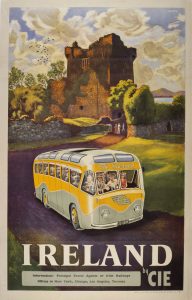
Medieval gold ring brooch and stone, Cloosmore, Dingle, Co. Kerry.
A medieval period gold ring brooch acquired by the National Museum of Ireland in 2016 is to be sent on a short-term loan to Músaem Chorca Dhuibhne, Baile an Fheirtéaraigh, close to where it was found. The curator at the museum in Baile an Fheirtéaraigh, Isabel Bennett, was instrumental in reporting the find. and the National Museum of Ireland is very grateful to her and especially to the finder, Mr Ian Andrew, who found the brooch by chance while walking on the beach at Cloosmore, Dingle.
Ring brooches were worn in medieval times by both men and women in order to fasten their gowns or cloaks at the neck. They may have been offered as a sign of affection or as betrothal gifts. Approximately 150 ring brooches are known from Ireland, but would usually be of copper alloy. Only a very small number including this example are made of gold.
The finder Ian Andrew was on a holiday visit to the Dingle peninsula, where he has strong family connections. While walking along a rocky coastal foreshore, he noticed a bright light shining between some rocks. After taking a closer look, he identified and retrieved this tiny but exquisite gold ring brooch. It is an example of a rare type of 13th/14th century ring brooch with projecting hands. The brooch has a blue stone setting of tourmaline. The inscription in Gothic style lettering is legible but their meaning is unclear.a




 The Enemy Within – The Spanish Flu in Ireland 1918-19, a new exhibition on the Spanish Flu that swept across Ireland 100 years ago, opens tomorrow at the National Museum of Ireland – Country Life in Turlough Park, Castlebar, Co. Mayo. The Spanish Flu claimed 23,000 lives and infected some 800,000 people in Ireland over a 12-month period from 1918 to 1919. No group, location or aspect of life was spared. However, the epidemic remains an almost forgotten event in 20th-century Irish history.
The Enemy Within – The Spanish Flu in Ireland 1918-19, a new exhibition on the Spanish Flu that swept across Ireland 100 years ago, opens tomorrow at the National Museum of Ireland – Country Life in Turlough Park, Castlebar, Co. Mayo. The Spanish Flu claimed 23,000 lives and infected some 800,000 people in Ireland over a 12-month period from 1918 to 1919. No group, location or aspect of life was spared. However, the epidemic remains an almost forgotten event in 20th-century Irish history.
